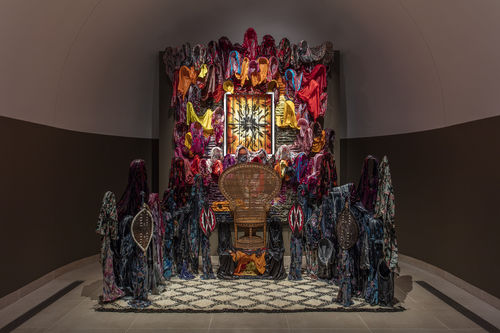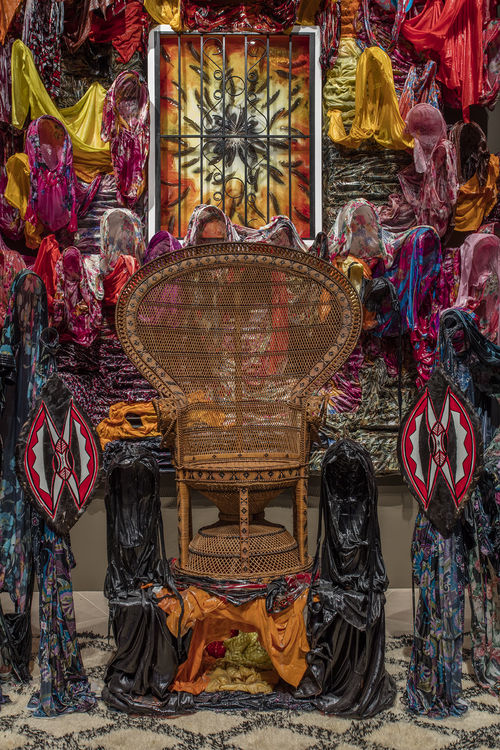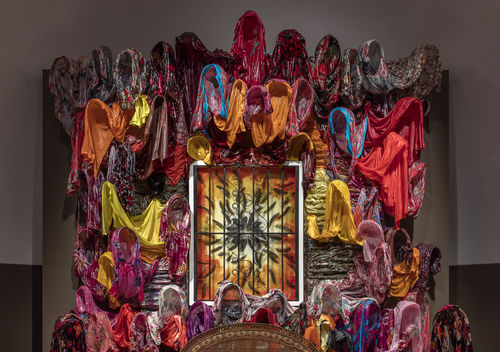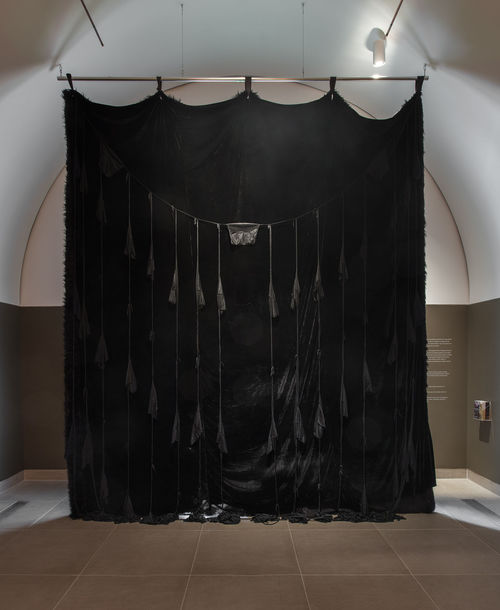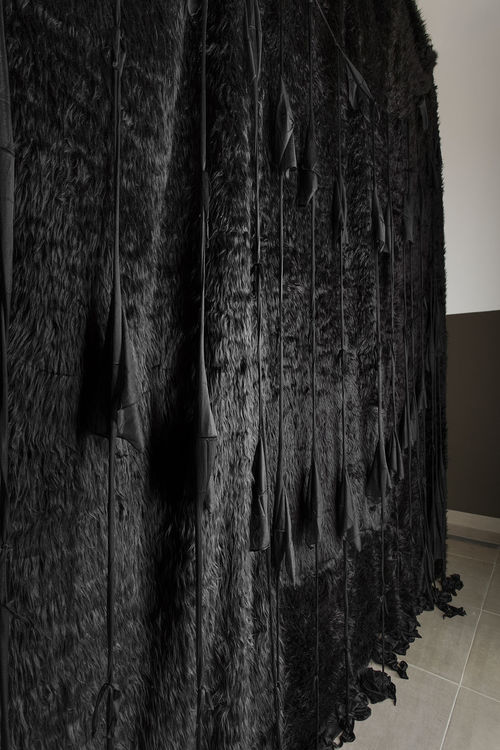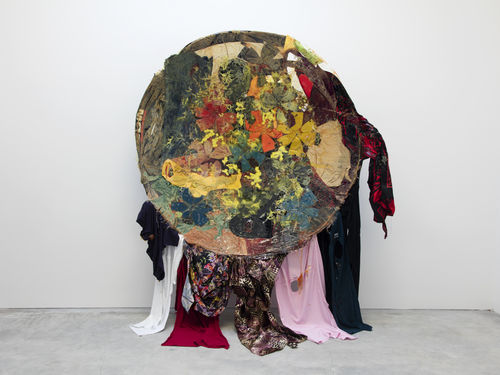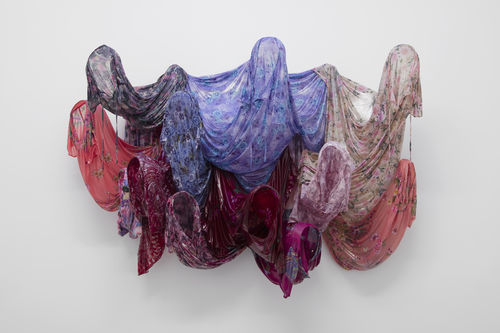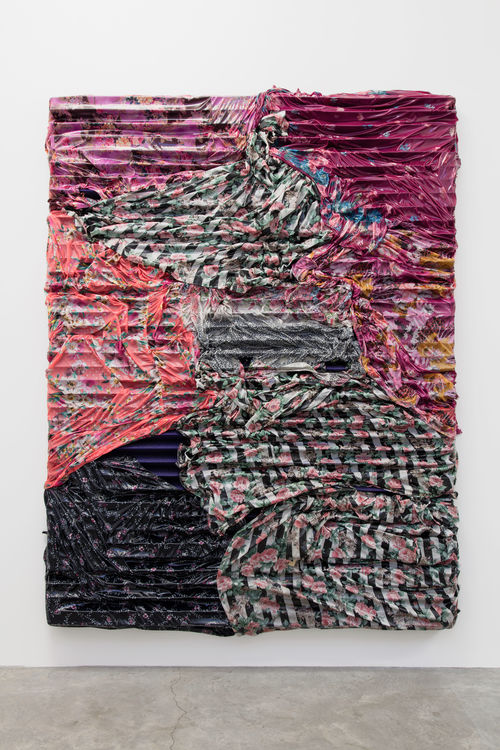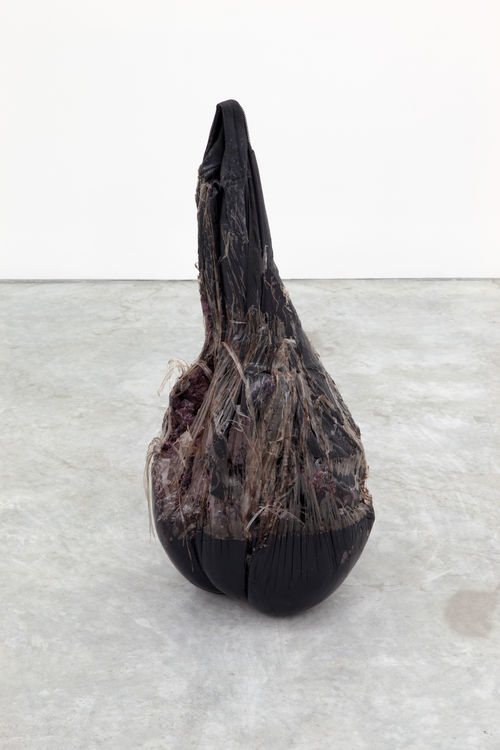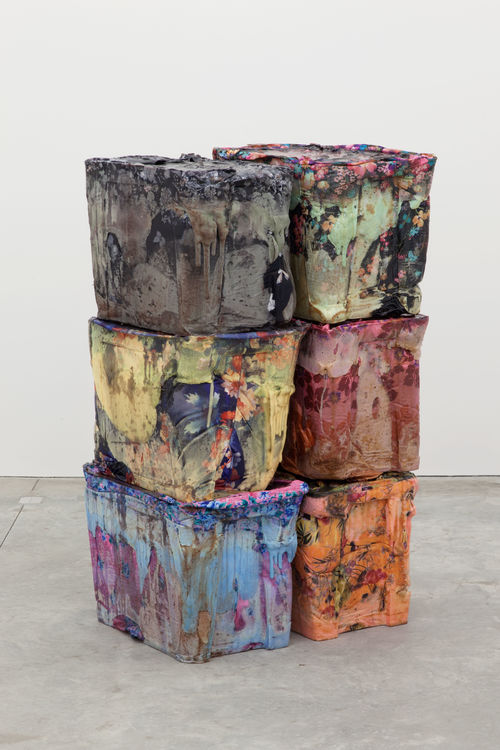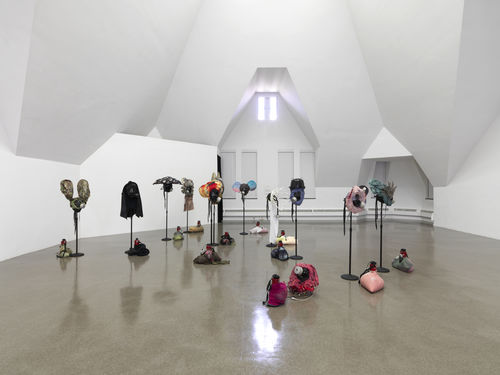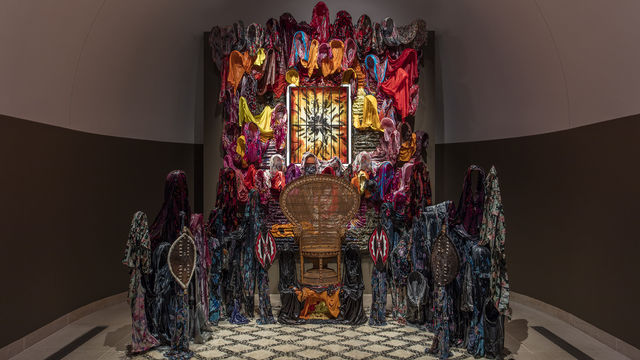
Hammer Projects: Kevin Beasley
- – This is a past exhibition
New York–based artist Kevin Beasley transforms the museum’s Vault Gallery into an elaborate environment inspired by Bernini’s Baroque altarpiece in Saint Peter’s Basilica and an infamous image of Black Panther Huey P. Newton.
The New York–based artist Kevin Beasley imbues his sculptures with both personal associations and references to current events, social movements, and economic realities. Using resin and foam to give shape and solidity to soft materials such as T-shirts, house dresses, and bandannas, he gives his works a pronounced presence while also calling attention to what is absent. The remnants of bodies in the form of used clothing, or materials like acoustic foam panels, which give shape to the elusiveness of sound, are activated in a practice rooted in assemblage. Inspired by the Vault Gallery’s arched ceiling’s allusion to sacred architecture, the installation is a contemporary interpretation of Bernini’s seventeenth-century Baroque altarpiece in Saint Peter’s Basilica in Rome. Beasley replaces Saint Peter’s chair with a wicker “peacock” chair of the type that became iconic after Black Panther Party founder Huey P. Newton was photographed seated in one holding a shotgun in one hand and a spear in the other. In Beasley’s remix, two historical references are united to create an environment that is bold and lively while simultaneously ghostly and mournful.
BIOGRAPHY
Kevin Beasley (b. 1985, Lynchburg, Virginia) lives and works in New York. He received his BFA from the College for Creative Studies, Detroit, in 2007, and an MFA from Yale University School of Art in 2012. He has had solo exhibitions at the Studio Museum, Harlem (2016); the High Line, New York (2015); and the Glass House, New Canaan, Connecticut (2015). His work has been featured in group exhibitions at Pace Gallery, New York (2016); the Renaissance Society at the University of Chicago (2016); Hammer Museum at Art + Practice, Los Angeles (2016); the Rennie Museum, Vancouver (2016); White Columns, New York (2016); the Solomon R. Guggenheim Museum, New York (2015); MoMA PS1, New York (2014); the Museum of Modern Art, New York (2014); and the Museum of Contemporary Art, Cleveland (2013), among others. He was in the 2013 Queens International at the Queens Museum, the 2014 Whitney Biennial, and the 2015 Greater New York at MoMA PS1. He has performed at the High Line, New York (2015); Art Gallery of Ontario, Toronto (2015); the Dallas Museum of Art (2015); the Whitney Biennial (2014); the Walker Art Center, Minneapolis (2014); and the Museum of Modern Art, New York (2012). He has been an artist in residence at MoMA PS1, New York (2013); the Studio Museum, Harlem (2013); International Studio & Curatorial Program (ISCP), Brooklyn (2013); and the Museum of Contemporary Art, Cleveland (2013). Beasley is co-creator of ALLGOLD, an artist-designer group that facilitates community and enables exploration and exchange in New York and abroad.
Essay
“We cannot represent ourselves. We can’t be represented.” —Fred Moten and Stefano Harney, The Undercommons: Fugitive Planning and Black Study, 2013
In the past, nothing was more effective in establishing evidence, even proving guilt and achieving justice, than the camera’s lens. Yet today, the capacity of the photographic to bear witness and offer testimony is being lost to forces we have yet to fully understand, but that certainly stem, in part, from our utter saturation with images. We are becoming increasingly cynical of long-standing social institutions like the media, the police, and certainly politicians, and a pernicious skepticism is establishing a strong foothold in our political systems and forums of democracy. This is perhaps best exemplified by the failure of evidentiary video footage to result in convictions in deaths of black men and women at the hands of police. As David Joselit points out in his short 2015 essay, “Material Witness,” “With regard to the [Eric] Garner case, as well as our own affairs in the art world, we need to be more skeptical of the ideological promises of representation.”1 In other words, our long-standing reliance on the power of images—particularly of the documentary photographic ilk—in struggles for human rights is being compromised. Today’s culture of “truthiness” and fake news has resulted in a growing inability to see anything as real, as true, as substantive enough to tell the whole story. Images are becoming less powerful, and thus less empowering. This, coupled with our ever more asinine obsession with individualism over community and collectivity, turns everything into simply a “perspective” or an “opinion.” Consensus building is now an art form with which few are adept.
With this context in mind, Kevin Beasley proposes that contemplating particular historical images that were constructed to express, generate, and maintain power, for better or for worse, can be a meaningful exercise in deconstructing today’s hornet’s nest of media saturation. To evaluate specific historical uses of iconography might facilitate moving away from generalizations that serve to flatten difference and toward a new understanding of the value of forms of representation. To that end, Beasley brings together two seemingly unlikely antecedents: Gian Lorenzo Bernini’s seventeenth-century Baroque altarpiece for Saint Peter’s Basilica in Rome, and the iconic 1967 photograph of Black Panther Party founder Huey P. Newton wearing the party uniform of black leather jacket and beret, holding a shotgun in one hand and a spear in the other. The visually abundant installation underscores the allusion to sacred space proposed by the gallery’s vaulted ceilings, an architectural style long outmoded in most venues for contemporary art, while suggesting that as a culture we need quiet spaces in which to contemplate and evaluate images and the meanings they deliver.
The centerpiece of Bernini’s papal altar is the cathedra Petri, or St. Peter’s throne. The first Roman Catholic pope, St. Peter, is buried underneath the basilica, and Bernini placed the empty throne over his tomb to symbolically represent him. It appears to hover, unmoored, as if ascending to heaven, yet its resonant physical presence argues for St. Peter’s continued relevance and influence. Interestingly, the throne itself houses a relic—the actual wooden chair used by St. Peter, encased in an elaborate bronze replica, which thus becomes its reliquary. This strange combination of the real and the fabricated—the mannered, the manipulated, the staged—is a strategy that has been used by many artists, including countless photographers, in the centuries since. It is the driving force behind the image of Huey P. Newton, which was originally taken for the first issue of the Black Panther Party newsletter, where it appeared above their Ten-Point Platform. Although no one seems to recall who took the photograph, the intention was clearly to project resolute power. A group of party members had convened at attorney Beverly Axelrod’s home in San Francisco, and Eldridge Cleaver set the scene, believing that the symbols of African culture like the spear and Maasai and Zulu war shields would resonate with their supporters, and perhaps intimidate their detractors. The photograph was later reproduced in a New York Times article about the Black Panthers, further establishing its status as a signifier of their agenda. It soon became an iconic, nationally known image representing the party.
The picture’s marketing savvy extended beyond a sense of style or tapping into a countercultural craze for African and Asian aesthetics. It reflected a deep understanding of art history. Directly quoting Jean-Auguste-Dominique Ingres’s painting Napoleon I on His Imperial Throne (1806), the photograph adopts the large rounded throne extending well above the head, the accompanying acoutrements of position and power, the rug below, and the pose, with its unflinching outward stare. Masterfully using the genre of the portrait for self-glorification, Napoleon appears in this painting almost like a god. Many understood the photograph of Newton to likewise present him as a quasi-mythical figure in the budding revolution. As fellow Panther Bobby Seale noted, Newton consistently emphasized there was always a way to respond to fear, to create a shield as a reaction to the threat of a spear: “He represented a shield for black people against all the imperialism, the decadence, the aggression, and the racism in this country.”2
The wicker “peacock” chair has been circling around Beasley’s subconscious ever since he saw the unforgettable image of Newton as a kid. And although he is not directly inspired by Bernini or other canonical Baroque figures, Beasley feels an affinity for their exuberant, twisted forms and figures. Having recently located a vintage 1970s peacock chair, he began to imagine replacing Bernini’s throne for St. Peter with this more contemporary “throne,” conflating a piece of modern iconography with a historical one. Beasley likewise doesn’t find a particular personal relevance in St. Peter’s Basilica in terms of its geographic or religious aspects, but he does certainly appreciate it as a space brilliantly designed to project a strong image-argument on behalf of a particular entity, the Catholic Church, which was grappling at that post-Reformation moment with power, morality, faith, longevity, and values. He recognized that these conditions were central to the political movements in the United States in the 1960s and 1970s, especially those that, as he puts it, “truly spoke to all of these issues for black people in a way that we had never been spoken to before.”3 Could a contemporary interpretation of the Baroque resonate with current concerns about the body, particularly the black male body? Could the process make an argument for the continued generative potential of sculpture? And, could it re-inscribe, in some small way, the role of images in the empowerment of people?
Situated at the back of the gallery, in a space reminiscent of the apse of the basilica, Chair of the Ministers of Defense(2016) references Newton’s official rank and title within the Black Panther Party. Beasley has replaced the four church fathers surrounding the pope’s chair—white, male, privileged—with ghostly figures he calls sentinels, guarding the empty throne of their fallen warrior. A clash and entwinement of ideologies and social institutions—church and state, military and revolutionaries, politicians and priests—is visualized through the amalgamation of numerous figures, some of whom carry Maasai and Zulu war shields. As in his earlier works, Beasley’s figures are composed of clothing, much of it commonly associated with urban youth or the garb of specific racial groups: jeans, trousers, du-rags, T-shirts, hoodies, kaftans, housedresses. Given shape through the application of resin, the disembodied sentinels are both ethereal and distinctly present, powerful signifiers of the many bodies lost in our ongoing political struggles, including, of course, Newton—a primary figure in a movement that defined itself as strictly political, without the church affiliations that characterized Martin Luther King Jr.’s methods. In keeping with Beasley’s ongoing interest in combining the personal with the political, some of the clothing is his own, and the numerous housedresses are a reference to his grandmother and other African American women of her generation. Above the throne, rather than Bernini’s stained-glass window showing a dove in flight, we see an ordinary house window with iron security bars. Captured in a colorful resin panel are dozens of guinea fowl feathers, which have both personal and cultural symbolism for the artist. Considered a sacred bird of protection in many African cultures, the guinea fowl is associated with daily efforts for survival. Beasley’s grandparents had a flock of them on their farm in Virginia, to reduce the tick population and to sound the alarm should a predator come for their chickens. Thus, the guinea fowl served as a protector for Beasley and his family, too, bridging time and space to provide a similar function.
Beasley’s interpretation of St. Peter’s altar is also a study in the integrity of form, proposing that the formal innovations of an earlier period in art might be enlivened not through mere mimicry but by altering the materials and subject matter to make them specific to our cultural moment. The intention is not to create an altar to a fallen hero, or to a political movement whose founding fifty years ago marked a moment of great hope for substantive change in this country. Rather, Chair of the Ministers of Defense captures some of the energy of the ideals of empowerment and community espoused by the Black Panther Party, and provides a space for respite and protected reflection in a time of great upheaval and uncertainty.
—Anne Ellegood
Notes
1. David Joselit, “Material Witness: Visual Evidence and the Case of Eric Garner,”
Artforum (February 2015).
2. Bobby Seale, Seize the Time: The Story of the Black Panther Party and Huey P.
Newton (Baltimore: Black Classic Press, 1991), quoted in Jo-Ann Morgan,
“Huey P. Newton Enthroned–Iconic Image of Black Power,” Journal of American
Culture 37, no. 2 (June 2014): 141.
3. Email from the artist, December 20, 2016.
Hammer Projects: Kevin Beasley is organized by Anne Ellegood, senior curator, with MacKenzie Stevens, curatorial assistant.
Hammer Projects is presented in memory of Tom Slaughter and with support from the Horace W. Goldsmith Foundation.
Hammer Projects is made possible by a gift from Hope Warschaw and John Law. Generous support is also provided by Susan Bay Nimoy and Leonard Nimoy. Additional support is provided by Good Works Foundation and Laura Donnelley.



